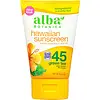What's inside
What's inside
 Key Ingredients
Key Ingredients

 Benefits
Benefits

 Concerns
Concerns

 Ingredients Side-by-side
Ingredients Side-by-side

Butyl Methoxydibenzoylmethane 3%
UV AbsorberHomosalate 10%
Skin ConditioningOctocrylene 10%
UV AbsorberEthylhexyl Salicylate 5%
UV AbsorberWater
Skin ConditioningCetyl Alcohol
EmollientGlycerin
HumectantGlyceryl Stearate Se
EmulsifyingDimethicone
EmollientCaprylic/Capric Triglyceride
MaskingVp/Hexadecene Copolymer
Citrus Aurantium Dulcis Peel Oil
MaskingAloe Barbadensis Leaf Juice
Skin ConditioningCalendula Officinalis Flower Extract
MaskingCamellia Sinensis Leaf Extract
AntimicrobialChamomilla Recutita Flower Extract
MaskingGinkgo Biloba Leaf Extract
Skin ConditioningLavandula Angustifolia Flower Extract
CleansingTocopheryl Acetate
AntioxidantAlcohol
AntimicrobialCetearyl Alcohol
EmollientCetearyl Olivate
Citric Acid
BufferingLinalyl Acetate
MaskingPolysorbate 60
EmulsifyingSodium Chloride
MaskingSodium Stearoyl Glutamate
CleansingSorbitan Olivate
EmulsifyingTriethyl Citrate
MaskingXanthan Gum
EmulsifyingBenzyl Alcohol
PerfumingPotassium Sorbate
PreservativeSodium Benzoate
MaskingAmyl Cinnamal
PerfumingCitral
PerfumingCitronellol
PerfumingGeraniol
PerfumingHydroxycitronellal
PerfumingLimonene
PerfumingLinalool
PerfumingButyl Methoxydibenzoylmethane 3%, Homosalate 10%, Octocrylene 10%, Ethylhexyl Salicylate 5%, Water, Cetyl Alcohol, Glycerin, Glyceryl Stearate Se, Dimethicone, Caprylic/Capric Triglyceride, Vp/Hexadecene Copolymer, Citrus Aurantium Dulcis Peel Oil, Aloe Barbadensis Leaf Juice, Calendula Officinalis Flower Extract, Camellia Sinensis Leaf Extract, Chamomilla Recutita Flower Extract, Ginkgo Biloba Leaf Extract, Lavandula Angustifolia Flower Extract, Tocopheryl Acetate, Alcohol, Cetearyl Alcohol, Cetearyl Olivate, Citric Acid, Linalyl Acetate, Polysorbate 60, Sodium Chloride, Sodium Stearoyl Glutamate, Sorbitan Olivate, Triethyl Citrate, Xanthan Gum, Benzyl Alcohol, Potassium Sorbate, Sodium Benzoate, Amyl Cinnamal, Citral, Citronellol, Geraniol, Hydroxycitronellal, Limonene, Linalool
Titanium Dioxide 6%
Cosmetic ColorantZinc Oxide 4.7%
Cosmetic ColorantC12-15 Alkyl Benzoate
AntimicrobialButyloctyl Salicylate
Skin ConditioningNeopentyl Glycol Diethylhexanoate
EmollientParaffin
PerfumingEuphorbia Cerifera Wax
Ozokerite
Emulsion StabilisingDimethicone
EmollientBeeswax
Emulsion StabilisingPolyethylene
AbrasiveCetyl Alcohol
EmollientCeramide NP
Skin ConditioningCeramide AP
Skin ConditioningCeramide EOP
Skin ConditioningCholesterol
EmollientPhytosphingosine
Skin ConditioningSodium Hyaluronate
HumectantPolyhydroxystearic Acid
EmulsifyingAluminum Hydroxide
EmollientStearic Acid
CleansingBHT
AntioxidantCarbomer
Emulsion StabilisingTriethoxycaprylylsilane
Isostearic Acid
CleansingSodium Lauroyl Lactylate
EmulsifyingXanthan Gum
EmulsifyingTitanium Dioxide 6%, Zinc Oxide 4.7%, C12-15 Alkyl Benzoate, Butyloctyl Salicylate, Neopentyl Glycol Diethylhexanoate, Paraffin, Euphorbia Cerifera Wax, Ozokerite, Dimethicone, Beeswax, Polyethylene, Cetyl Alcohol, Ceramide NP, Ceramide AP, Ceramide EOP, Cholesterol, Phytosphingosine, Sodium Hyaluronate, Polyhydroxystearic Acid, Aluminum Hydroxide, Stearic Acid, BHT, Carbomer, Triethoxycaprylylsilane, Isostearic Acid, Sodium Lauroyl Lactylate, Xanthan Gum
Ingredients Explained
These ingredients are found in both products.
Ingredients higher up in an ingredient list are typically present in a larger amount.
Cetyl Alcohol is a fatty alcohol. Fatty Alcohols are most often used as an emollient or to thicken a product.
Its main roles are:
Though it has "alcohol" in the name, it is not related to denatured alcohol or ethyl alcohol.
The FDA allows products labeled "alcohol-free" to have fatty alcohols.
Learn more about Cetyl AlcoholDimethicone is a type of synthetic silicone created from natural materials such as quartz.
What it does:
Dimethicone comes in different viscosities:
Depending on the viscosity, dimethicone has different properties.
Ingredients lists don't always show which type is used, so we recommend reaching out to the brand if you have questions about the viscosity.
This ingredient is unlikely to cause irritation because it does not get absorbed into skin. However, people with silicone allergies should be careful about using this ingredient.
Note: Dimethicone may contribute to pilling. This is because it is not oil or water soluble, so pilling may occur when layered with products. When mixed with heavy oils in a formula, the outcome is also quite greasy.
Learn more about DimethiconeXanthan gum is used as a stabilizer and thickener within cosmetic products. It helps give products a sticky, thick feeling - preventing them from being too runny.
On the technical side of things, xanthan gum is a polysaccharide - a combination consisting of multiple sugar molecules bonded together.
Xanthan gum is a pretty common and great ingredient. It is a natural, non-toxic, non-irritating ingredient that is also commonly used in food products.
Learn more about Xanthan Gum